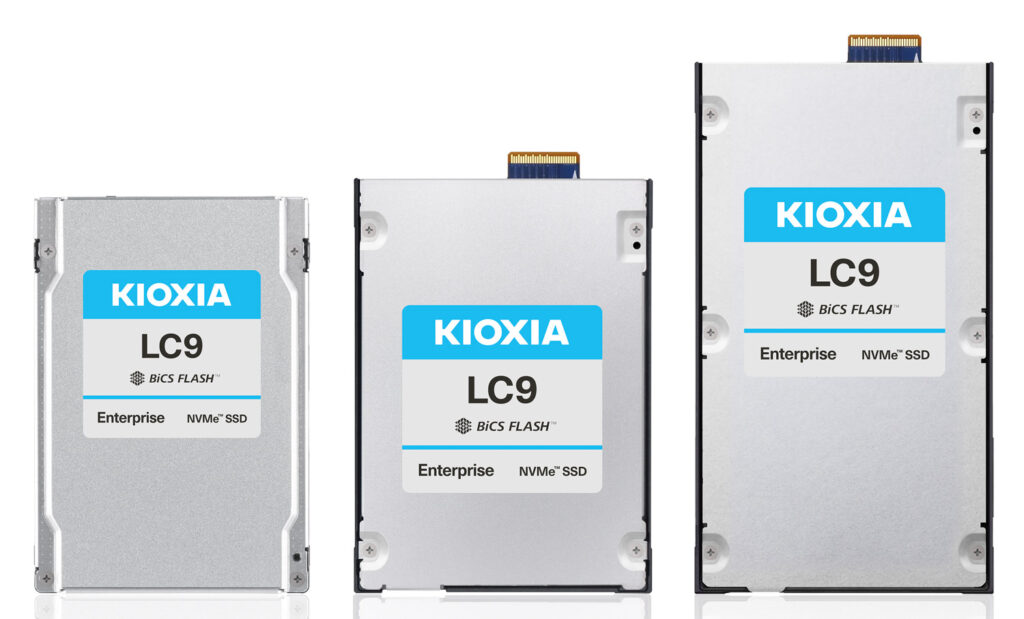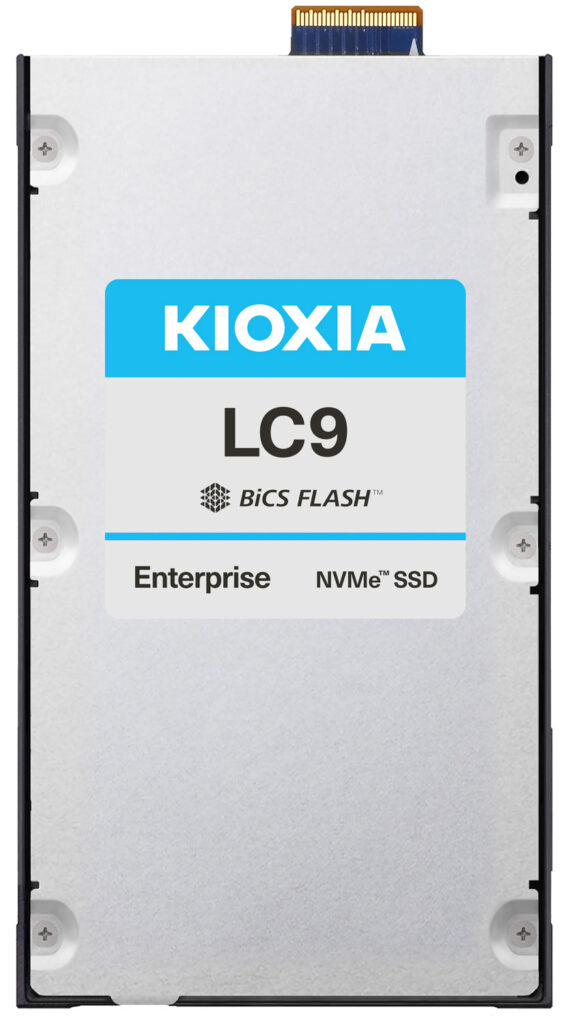KIOXIA has introduced the industry’s first 245.76TB NVMe SSD with the launch of its latest LC9 Series drive, pushing the limits of flash density in a compact, power-efficient form factor. Designed for data-intensive workloads, such as generative AI, vector databases, and massive-scale data lakes, the LC9 Series delivers breakthrough capacity in both 2.5-inch and EDSFF E3.S and E3.L designs. The 245TB-capacity SSD appears to be the largest SSD ever widely produced and shipped.

Built on KIOXIA’s eighth-generation BiCS FLASH QLC NAND and advanced CBA packaging, these SSDs support up to 12GB/s sequential read and 3GB/s write speeds, delivering 1.3 million random read IOPS. This balance of performance and storage density makes them ideal for high-scale environments. Capacities range from 30.72TB to 245.76TB, with endurance rated up to 0.3 DWPD, and options for dual-port connectivity and enterprise-grade security.
While the U.2 and E3.S form factors remain mainstays in enterprise storage, KIOXIA’s decision to offer the LC9 Series in EDSFF E3.L reflects a broader push by flash vendors to explore higher-capacity designs tailored for dense server environments. Compared to the more widely adopted E3.S, which prioritizes performance in a compact footprint, E3.L offers significantly more physical space, ideal for accommodating larger NAND packages and more aggressive thermal designs, making it a natural fit for high-capacity QLC SSDs like the LC9.

KIOXIA LC9 E3.L
However, this growing diversity in SSD form factors, including new options like the emerging E2 form factor, is adding pressure to server designers who now face the challenge of supporting multiple backplanes across their product lines. While the intent is to give hyperscalers and enterprises more flexibility, the reality is a fragmented ecosystem that can complicate system integration and inventory planning. Nevertheless, we expect the industry will be pretty enthusiastic about having more high-capacity options.
| KIOXIA LC9 Series Key Specifications | |
|---|---|
| User Capacity (GB) | 30,720 / 61,440 / 122,880 / 245,760 |
| Form Factor | 2.5-inch, E3.S (up to 122.88TB) E3.L (up to 245.76TB) |
| Endurance (DWPD) | Up to 0.3 |
| Sequential Read (128 KiB, QD32) | Up to 12,000 MB/s |
| Sequential Write (128 KiB, QD32) | Up to 3,000 MB/s |
| Random Read (4 KiB, QD512) | Up to 1,300 KIOPS |
| Random Write (16 KiB, QD32) | Up to 50 KIOPS |
Inside the 245 TB LC9: BiCS FLASH QLC and CBA Density Advances
At the heart of the LC9’s breakthrough capacity is KIOXIA’s eighth-generation BiCS FLASH QLC NAND, configured with a 32-die stack of 2Tb dies. This is an aggressive architectural choice that maximizes density while still meeting performance targets. Each die stack uses KIOXIA’s CMOS Bonded to Array (CBA) technology, which physically connects the peripheral CMOS circuitry directly onto the NAND cell array at the wafer level. This vertical integration eliminates the limitations of traditional wire-bonded configurations, enabling shorter signal paths, reduced latency, and tighter packing.
The result is an 8TB package within a compact 154-ball BGA footprint measuring just 11.5 by 13.5 millimeters, making it one of the densest NAND packages currently in production. These packages are deployed in parallel across a proprietary KIOXIA controller and firmware platform to achieve the LC9’s full 245.76TB capacity. This strategy builds on techniques refined through earlier BiCS FLASH generations. It is supported by features like Flexible Data Placement (FDP), which reduces write amplification and improves endurance, particularly in AI and hyperscale environments where data volumes and access patterns are unpredictable.
The KIOXIA LC9 Series also supports dual-port operation, enabling high-availability configurations. It features power loss protection (PLP) and end-to-end data protection to maintain data integrity during transfer and unexpected shutdown events. Security options include Sanitize Instant Erase (SIE), Self-Encrypting Drive (SED), and FIPS SED models, with FIPS 140-3 compliance planned. The drive supports the Leighton-Micali Signature (LMS) algorithm, which is aligned with the Commercial National Security Algorithm Suite 2.0 (CNSA 2.0) standards, and utilizes AES-256 encryption. The LC9 is compliant with PCIe Gen5 and NVMe 2.0 specifications, and it supports select elements of the Open Compute Project (OCP) Datacenter NVMe SSD specification, version 2.5.
A Shift Toward Flash for Warm Data
As organizations deal with expanding data lakes and AI pipelines that demand high throughput and large capacity, high-density SSDs, such as the KIOXIA LC9, are beginning to fill roles traditionally served by hard drives. These drives are particularly well-suited for warm data, datasets that must remain accessible but do not require the cost or performance of the fastest tier. In large-scale deployments, consolidating multiple HDDs into a single high-capacity SSD can simplify storage architecture, improve power efficiency, and reduce both physical footprint and cooling requirements.
With capacities reaching nearly a quarter of a petabyte per device, the potential impact on system density is significant. Today, servers like Dell’s PowerEdge family can be configured with up to 40 E3.S drives in just 2U. If that same system were adapted for E3.L, it could theoretically support over 9.8 petabytes of flash storage in a single chassis using LC9 Series SSDs.
KIOXIA LC9 Availability
To date, the highest-capacity SSD we’ve tested in the lab is Solidigm’s 122.88TB model. Seeing a 245.76TB drive now available marks a significant milestone, and we’re looking forward to getting the LC9 Series in for hands-on evaluation. It’s a positive signal for the industry that capacity leadership is not just a marketing metric; enterprises are deploying these large drives, and flash vendors are responding with meaningful innovations and real-world availability.
KIOXIA is currently sampling the LC9 Series for select customers and will showcase the drive at the Future of Memory and Storage 2025 event, taking place from August 5 to 7 in Santa Clara.




 Amazon
Amazon